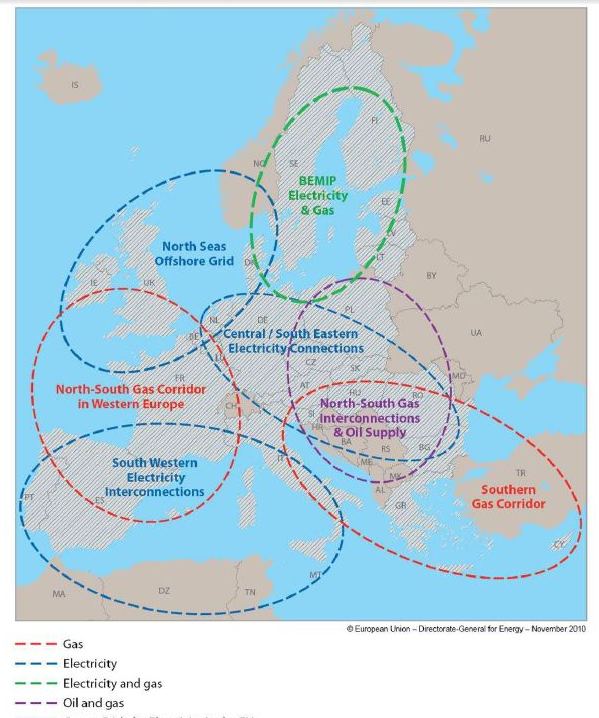The EU’s goals for a competitive, sustainable, and secure supply of energy for all member countries is best achieved when energy is available from a wide range of sources. And often, these energy sources are located far from the areas of highest demand, the major markets.
The requirements for infrastructure are addressed in the EU communication, Energy infrastructure priorities for 2020 and beyond - A Blueprint for an integrated European energy network.

The excerpt below sets the stage for understanding the map above. More details are provided in the assigned reading. The excerpt is from the opening section of Energy infrastructure priorities for 2020 and beyond - A Blueprint for an integrated European energy network.
1. Introduction
Europe's energy infrastructure is the central nervous system of our economy. EU energy policy goals, as well as the Europe 2020 economic aims, will not be achievable without a major shift in the way European infrastructure is developed. Rebuilding our energy system for a low-carbon future is not just a task for the energy industry. Technological improvements, greater efficiencies, resilience to a changing climate, and new flexibility will be necessary.
This is not a task which a single Member State can achieve on its own. A European strategy, and funding, will be necessary.
The Energy Policy for Europe, agreed by the European Council in March 2007, establishes the Union’s core energy policy objectives of competitiveness, sustainability, and security of supply. The internal energy market has to be completed in the coming years and by 2020 renewable sources have to contribute 20% to our final energy consumption, greenhouse gas emissions have to fall by 20%, and energy efficiency gains have to deliver 20% savings in energy consumption. The EU has to assure security of supply to its 500 million citizens at competitive prices against a background of increasing international competition for the world's resources. The relative importance of energy sources will change. For fossil fuels, notably gas and oil, the EU will become even more dependent on imports. For electricity, demand is set to increase significantly.
The Energy 2020 Communication, adopted on 10 November 2010, called for a step change in the way we plan, construct, and operate our energy infrastructures and networks. Energy infrastructures are at the forefront of the flagship initiative "Resource efficient Europe."
Adequate, integrated, and reliable energy networks are a crucial prerequisite not only for EU energy policy goals, but also for the EU's economic strategy. Developing our energy infrastructure will not only enable the EU to deliver a properly functioning internal energy market, it will also enhance security of supply, enable the integration of renewable energy sources, increase energy efficiency, and enable consumers to benefit from new technologies and intelligent energy use.
The EU pays the price for its outdated and poorly interconnected energy infrastructure. In January 2009, solutions to the gas disruptions in Eastern Europe were hindered by a lack of reverse flow options and inadequate interconnection and storage infrastructures. Rapid development of offshore wind electricity generation in the North and Baltic Sea regions is hampered by insufficient grid connections, both off- and onshore. Developing the huge renewables potential in Southern Europe and North Africa will be impossible without additional interconnections within the EU and with neighboring countries. The risk and cost of disruptions and wastage will become much higher unless the EU invests as a matter of urgency in smart, effective, and competitive energy networks, and exploits its potential for energy efficiency improvements.
[...]
A new EU energy infrastructure policy is needed to coordinate and optimize network development on a continental scale. This will enable the EU to reap the full benefits of an integrated European grid, which goes well beyond the value of its single components. A European strategy for fully integrated energy infrastructures based on smart and low-carbon technologies will reduce the costs of making the low-carbon shift through economies of scale for individual Member States. A fully interconnected European market will also improve security of supply and help stabilize consumer prices by ensuring that electricity and gas goes to where it is needed. European networks including, as appropriate, with neighboring countries, will also facilitate competition in the EU’s single energy market and build up solidarity among Member States. Above all, integrated European infrastructure will ensure that European citizens and businesses have access to affordable energy sources. This in turn will positively contribute to Europe's 2020 policy objective of maintaining a strong, diversified and competitive industrial base in Europe.
To Read Now
Referring to the map above, "EU priority corridors for electricity, gas and oil," open and read the EU publication, Energizing Europe.
